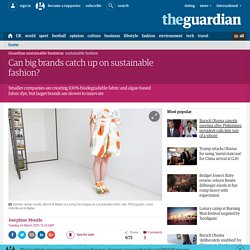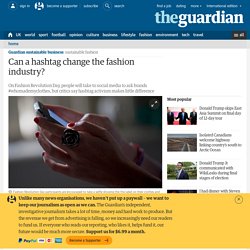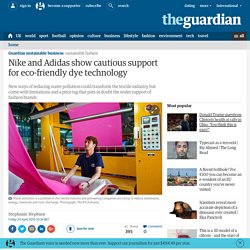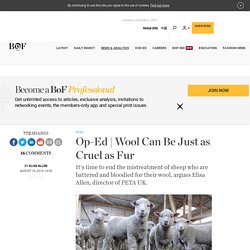

How can we safeguard the people who make our clothing? Can big brands catch up on sustainable fashion? Imagine a pair of trousers you could throw on the compost.

After years of use, they could decompose among the eggshells and tea bags to leave behind nothing but some fertile soil to help grow new raw materials. It takes the circular economy to a whole new level. This is the idea behind F-ABRIC, a range of materials developed by Swiss company Freitag. Until recently, Freitag’s only line of business was making bags out of old truck tarpaulins. While natural fibres like cotton will compost over time, synthetic fibres like polyester won’t, and natural fibres are often blended with synthetic. The fact that it is biodegradable does not make the fabric any less hard-wearing, says one of the founders, Daniel Freitag.
Freitag is not the only company looking to microorganisms for inspiration. Two years after Rana Plaza, have conditions approved in Bangladesh’s factories? On 24 April 2013, an eight-story garment factory collapsed in Dhaka, the capital of Bangladesh.

The building’s fall killed 1,134 people and injured hundreds of others. The Rana Plaza tragedy was not caused by an earthquake or a terrorist attack, but rather by poor construction and a lack of oversight – and, in some ways, by a growing global desire for more cheap fashion. It’s been two years since the Rana Plaza tragedy, and although much remains to be done to ensure the rights and safety of workers in Bangladesh’s still-booming garment industry, progress has been made. Global brands including H&M, Mango, Primark, the Gap and Walmart, among a dozen others, have contributed $21.5m to the Rana Plaza Donors Trust Fund, which was set up to award compensation to victims and their families.
According to Srinivas Reddy, Bangladesh director for the International Labour Organization (ILO), which is administering the fund, there is a shortfall of $8.5m. Safety, but not security Attention or pressure. Can a hashtag change the fashion industry? Now in its second year, Fashion Revolution Day (FRD) is a hashtag campaign designed to keep the most vulnerable in the fashion supply chain in the public eye.

Held on the anniversary of the Rana Plaza factory collapse in Bangladesh, participants are encouraged to take a selfie showing the label on their clothes and ask the designer or brand #whomademyclothes. It’s an important cause, but can a hashtag campaign really bring meaningful change to the fashion industry? Ruth Stokes, author of The Armchair Activist’s Handbook, says if a campaign is able to raise awareness and reach people otherwise not engaged, then it has provided something of value.
The challenge is translating that increased awareness into real-world practical actions, whether that means changing individual behaviors or the laws made by politicians. FRD has changed the hashtag this year to #whomademyclothes after Pixar took over #insideout in anticipation of the Disney animation film Inside Out. #whocares #meaningfulchange. Nike and Adidas show cautious support for eco-friendly dye technology.
It has been a significant step forward for the textile sector.

Up until now the effluent from dye houses that can often be seen in rivers flowing through the textile manufacturing areas of India, China and elsewhere is a result of unabsorbed dyes, chemicals and heavy salts that are used during the dyeing process. A number of companies, DyeCoo, ColorZen and AirDye have set out to address this pollution by designing waterless dye technology. The result is a reduction in wastewater, energy, chemicals and toxic discharge to such a degree that it could revolutionise the textile industry. Major brands including Nike and Adidas have been integrating waterless dye technologies into their product lines, but costs and limitations have experts in the textile industry worried that the support will not last. “Right now there is very low uptake of use of these technologies,” says Andrew Filarowski, technical director at Society of Dyers and Colourists.
H&M's 'Close The Loop' Collection Is Made From Your Old Clothes. Wool Can Be Just as Cruel as Fur. LONDON, United Kingdom — The fashion industry is shifting.

Led by a social and eco-conscious generation, today's consumers are increasingly demanding to know about the journey their garments took before arriving on the shop floor. It's this awareness that's caused a great many to ditch fur, exotic skins, and angora — after all, who can really feel good strutting around in a fur coat once you've seen images of foxes living alone and petrified in tiny cages and having their skin peeled off? Yet, somehow wool seems to have escaped such scrutiny — until now. Over the last year, PETA has released several video exposés of the wool industry, documenting cruelty at more than 30 farms and wool sheds across three continents, including Australia — the world's largest exporter of wool. Investigators also saw sheep penned and denied food and water the night before being shorn, in part to weaken them so they would put up minimal resistance.
Elisa Allen is director of PETA UK. Related Articles: